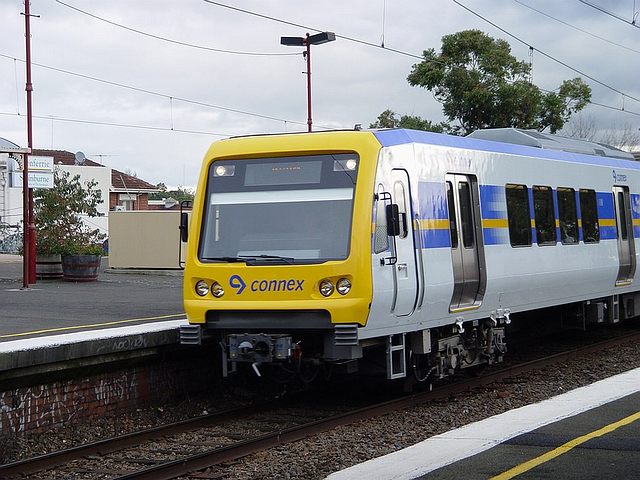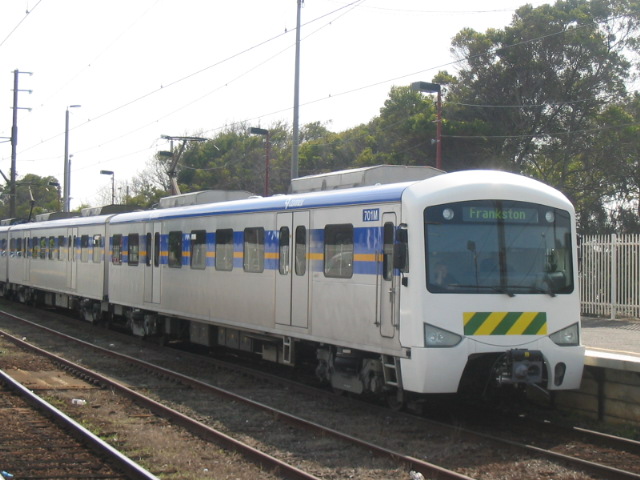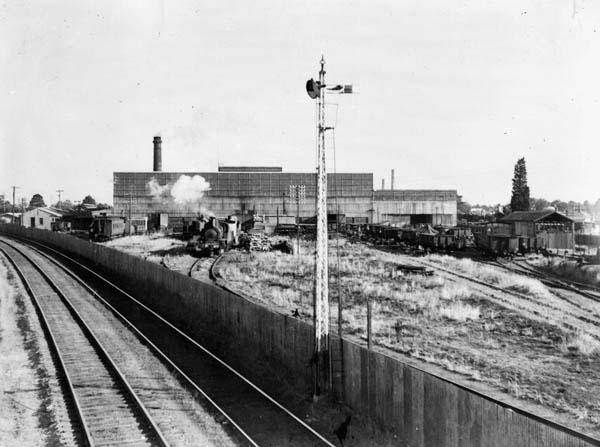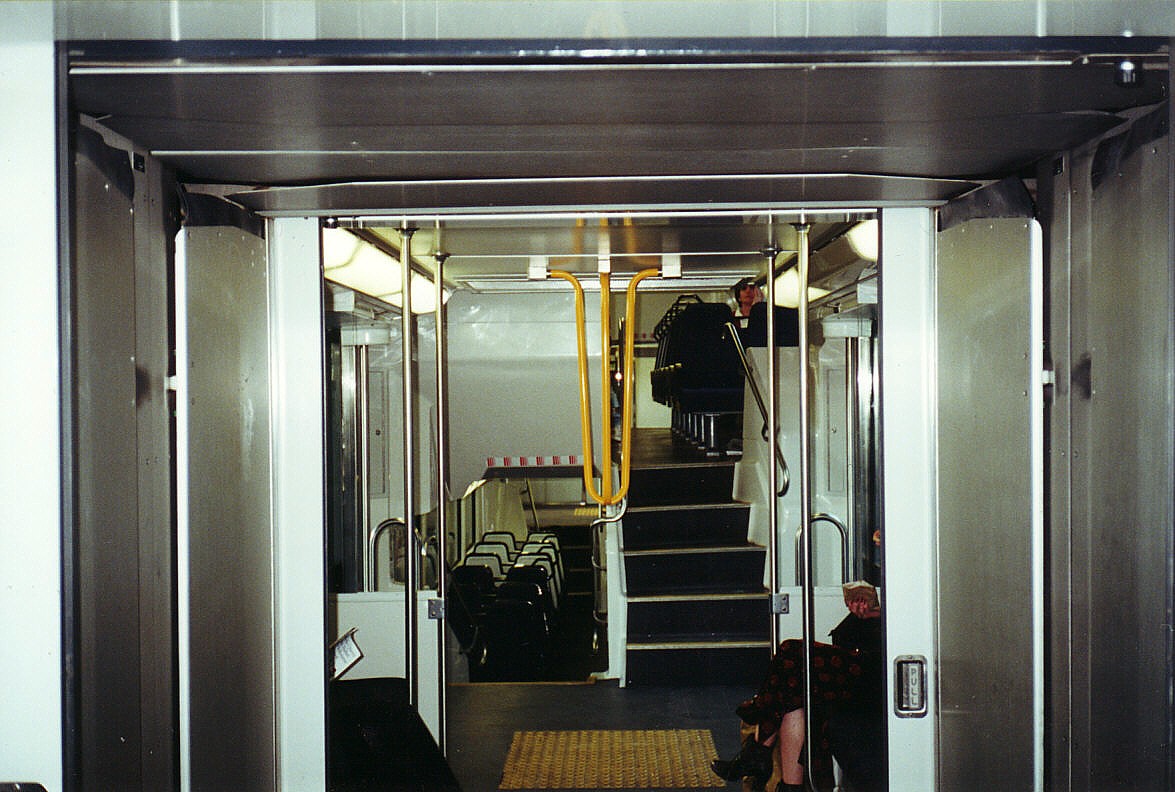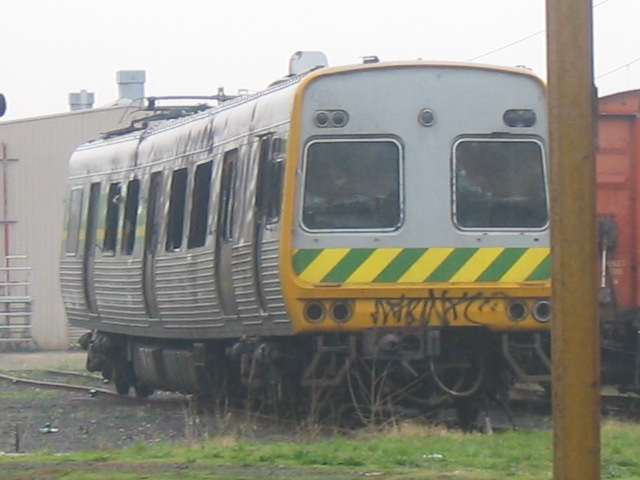|
Connex Melbourne
Connex Melbourne was a train operator in Melbourne, Australia. Formed in October 1997 as Hillside Trains, a business unit of the Public Transport Corporation, it was privatised in August 1999 becoming a subsidiary of Connex. In April 2004, it became the sole operator of Melbourne suburban rail services, taking over the services of M>Train. When the franchise was re-tendered, it was awarded to Metro Trains Melbourne from November 2009. History On 1 October 1997, in preparation for privatisation, the Public Transport Corporation's suburban rail operations were split into two business units, Bayside Trains and Hillside Trains. The latter took over operation of the Lilydale, Belgrave, Alamein, Glen Waverley, Epping (now Mernda) and Hurstbridge line services. Connex successfully bid to take over the Hillside Trains services from 29 August 1999 beating competition from GB Railways and National Express. It was rebranded Hillside Trains as Connex Melbourne in July 2000."Connex ... [...More Info...] [...Related Items...] OR: [Wikipedia] [Google] [Baidu] |
Public Transport Corporation
The Public Transport Corporation (PTC) was a Victoria State Government owned statutory authority formed under the Transport Act 1983 which operated passenger and freight trains, trams and bus services. The PTC was also responsible for directly operating some bus services and procuring bus services from private operators. It was established on 1 July 1989 as a result of the passage and commencement of the Transport (Amendment) Act 1989 to manage the responsibilities of the State Transport Authority and the Metropolitan Transit Authority. In suburban Melbourne it continued to be referred to by the MTA's nickname of ''The Met,'' while in regional Victoria it operated as V/Line. The operational rail and tram activities of the PTC were franchised in 1999 by the Kennett Government through the intermediary of a new agency, the Director of Public Transport, a statutory office within the Department of Transport. The director was required to enter into franchise agreements with priva ... [...More Info...] [...Related Items...] OR: [Wikipedia] [Google] [Baidu] |
National Express
National Express Group is a British multinational public transport company headquartered in Birmingham, England. It operates bus, coach, train and tram services in the United Kingdom, Ireland (National Express operates Eurolines in conjunction with Bus Éireann), United States, Canada, Spain, Portugal, Malta, Germany, Bahrain, and Morocco and long-distance coach services across Europe. It is listed on the London Stock Exchange and is a constituent of the FTSE 250 Index. History In 1972, the state-owned National Bus Company decided to bring together the scheduled coach services operated by its bus operating companies in the United Kingdom under one brand. Sir Frederick Wood, a prominent businessman and industrialist, was asked to oversee the creation of this new business model and led the group as its chairman from 1972 to 1978. Initially branded as ''National'', the ''National Express'' brand was first used in 1974.Tram and V/Line Passenger rail franchises in the Australi ... [...More Info...] [...Related Items...] OR: [Wikipedia] [Google] [Baidu] |
V/Line A Class
The A class are a class of diesel locomotives rebuilt from Victorian Railways B class locomotives by Clyde Engineering, Rosewater in South Australia for V/Line in 1984–1985. History The class were rebuilt from B class locomotives originally constructed in the 1950s, as part of the ''New Deal'' reforms of passenger rail operations in Victoria. The rebuild contract was let in January 1983 to Clyde Engineering, Rosewater with the first locomotive entering service in May 1984, but the project was abandoned in mid 1985 after rising costs due to structural fatigue, with the 11th rebuild delivered in August 1985. It was decided to instead built more of the N class locomotives, mechanically similar to the A class. The major difference was the addition of head end power generators, as it was believed this was a more efficient way of supplying power for air-conditioning and lighting than power vans or individual generator sets under carriages. Four locomotives were named after Aust ... [...More Info...] [...Related Items...] OR: [Wikipedia] [Google] [Baidu] |
Siemens Nexas
The Siemens Nexas is a class of electric multiple units manufactured by Siemens Transportation Systems for the suburban railway network of Melbourne, Australia between 2002 and 2005. The design of the trains was based on the Siemens Modular Metro. History In March 2000 M>Train ordered 62 Siemens Nexas trains to fulfill a franchise commitment to replace its fleet of Hitachi trains. The original order was for 62 3-car sets, with an option for an additional ten 3-car sets. In December 2002 just before the first was delivered, National Express handed the M>Train franchise back to the Government of Victoria, thus the first Siemens Nexas trains were delivered to the government. All passed to Connex Melbourne in April 2004. The option for ten additional trains was exercised in August 2005, with the last of these delivered in January 2006. Siemens Rail Services was contracted to provide maintenance of the trains for a period of 15 years (subject to refranchising) at Newport Works ... [...More Info...] [...Related Items...] OR: [Wikipedia] [Google] [Baidu] |
Ballarat North Workshops
Ballarat North Workshops is a railway systems engineering facility located in the provincial city of Ballarat, Victoria, Australia. They are located in the suburb of Soldiers Hill on Creswick Road, and occupy 5.5 hectares of land beside the junction of the Mildura and Serviceton railway lines. History The workshops were opened in April 1917 by the main rail operator in Victoria, the Victorian Railways. They were opened in response to political pressures from provincial groups for decentralisation, with the Victorian Railways preferring the cheaper option of expanding the existing Newport Workshops in suburban Melbourne. The main work carried out was repairs and maintenance of existing wagons and locomotives, but from 1919-22 thirteen new steam locomotives were also built - eight DD class (1038 - 1042, 1050 - 1052) and five A2 class (1073 - 1077) steam locomotives were also built. By the 1960s goods wagons were also being built, and by the 1980s work was also being carried out ... [...More Info...] [...Related Items...] OR: [Wikipedia] [Google] [Baidu] |
Alstom
Alstom SA is a French multinational rolling stock manufacturer operating worldwide in rail transport markets, active in the fields of passenger transportation, signalling, and locomotives, with products including the AGV, TGV, Eurostar, Avelia and New Pendolino high-speed trains, in addition to suburban, regional and metro trains, and Citadis trams. Alsthom (originally Als-Thom) was formed by a merger between Compagnie Française Thomson-Houston and the electric engineering division of Société Alsacienne de Constructions Mécaniques in 1928. Significant later acquisitions included the Constructions Electriques de France (1932), shipbuilder Chantiers de l'Atlantique (1976), and parts of ACEC (Belgium, late-1980s). A merger with parts of the General Electric Company (UK) formed GEC Alsthom in 1989. Throughout the 1990s, the company expanded its holdings in the rail sector, via the acquisition of German rolling stock manufacturer Linke-Hofmann-Busch and Italian rail signall ... [...More Info...] [...Related Items...] OR: [Wikipedia] [Google] [Baidu] |
X'Trapolis 100
The X'Trapolis 100 is a class of single deck electric multiple units part of Alstom's X'Trapolis family of trains, operated in Melbourne, Victoria, Australia and Valparaíso, Chile. Melbourne In service When originally introduced to the suburban network in 2002, the trains operated only on the former Hillside network (consisting of the Burnley and Clifton Hill group lines), and did not run revenue services elsewhere operated by M>Train on the Bayside Trains half of the system. Although the networks merged in 2004, when Connex took over all operations, the X'trapolis units did not operate on the Bayside system at the time. On 22 October 2014, the operation of X'Trapolis 100 trains was expanded to include lines on the former Bayside Trains network with the Frankston line being cleared for their operation and initially running two weekday morning-peak services. On 20 November 2016, X'Trapolis 100 trains were expanded to full-time running on the Frankston line and began oper ... [...More Info...] [...Related Items...] OR: [Wikipedia] [Google] [Baidu] |
Australian Railway History
''Australian Railway History'' is a monthly magazine covering railway history in Australia, published by the New South Wales Division of the Australian Railway Historical Society on behalf of its state and territory Divisions. Australian Railway Historical Society History and profile It was first published in 1937 as the ''Australasian Railway and Locomotive Historical Society Bulletin'', being renamed ''ARHS Bulletin'' in 1952. In January 2004, the magazine was re-branded as ''Australian Railway History''. Historically, the magazine had a mix of articles dealing with historical material and items on current events drawn from its affiliate publications. Today, it contains only historical articles, two or three of them being in-depth.Parameters * Size : A4; ...[...More Info...] [...Related Items...] OR: [Wikipedia] [Google] [Baidu] |
4D (train)
The 4D was a prototype double deck electric multiple unit built for the Public Transport Corporation in Victoria, Australia, for operation on the Melbourne railway system. It remains the only double deck train to have ever operated in Melbourne. The train's name stood for "Double Deck Development and Demonstration." Depending on sources, the intention was for this train to be the demonstration unit for a future order of either 20 or 50 extra sets, had the tests been successful. Design A tender for the design and construction of 19 double-deck trains was opened on 24 November 1989. The number of carriages to be built was at the discretion of the builder, however it had to comply with capacity and length requirements. By 11 April 1990, when the tender was closed, a number of tenders were received, including from Comeng and A Goninan & Co. However, the project was stopped by the State Government, due to financial constraints. Instead, The Met was granted approval to acquir ... [...More Info...] [...Related Items...] OR: [Wikipedia] [Google] [Baidu] |
Comeng (train)
The Comeng train ( ) is a type of electric multiple unit (EMU) that operates on the suburban railway network of Melbourne, Victoria, Australia. Built by Commonwealth Engineering (Comeng) in Dandenong, they were introduced in 1981 as a replacement for the Tait and Harris trains. In total, 570 carriages (380 motor cars and 190 trailer cars, a total of 95 six carriage sets) were built. Description Comeng trains are single deck and are semi-permanently coupled as M-T-M (motor-trailer-motor) sets. Most frequently, they are coupled as M-T-M-M-T-M (six-car) sets. Comeng trains have power operated doors that must be pulled open by hand but are closed by the driver. The trains were the first suburban trains in Melbourne to have air-conditioning in the passenger saloon. (The older Hitachi trains had driver only air-conditioning fitted more recently.) They operate in larger numbers on the Northern, Caulfield, Cross City and Sandringham group lines, and since 2017 it has been rare to ... [...More Info...] [...Related Items...] OR: [Wikipedia] [Google] [Baidu] |
Hitachi (Australian Train)
The Hitachi (also known as Martin & King or Stainless Steel) was an electric multiple unit that operated on the Melbourne suburban railway network between 1972 and 2014. Electrical equipment was supplied by Commonwealth Engineering to designs by Hitachi of Japan, leading to their official name today, though no actual Hitachi-supplied components were used in their construction. They were the last suburban trains in Melbourne with no air conditioning. A total of 355 carriages were built between 1972 and 1981, including a replacement carriage for one written off while the fleet was still being delivered. Configuration Based on a successful trial of longer Harris trailer cars built between 1967 and 1971, the Hitachi used carriages long, up from the standard length of the earlier suburban cars. The revised carriage design enabled a six car Hitachi to seat 560 passengers, up from 540 for a seven car Harris, and allowed a maximum load of 1,500 passengers, 300 more than a Harris ... [...More Info...] [...Related Items...] OR: [Wikipedia] [Google] [Baidu] |
